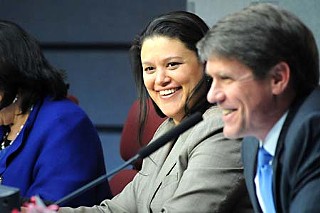Back to School
Carstarphen and Austin ISD trustees wrestle over priorities, budget, and power
By Richard Whittaker, Fri., March 5, 2010
When Pat Forgione retired last year after a decade as superintendent of the Austin Independent School District, he left for his successor one piece of advice. "What you gotta be careful of in Austin," he said, "you gotta bring the group to your vision."
That was in late February 2009, just days before the AISD board of trustees announced Meria Carstarphen as the sole finalist to fill Forgione's post. A year later, Carstarphen is making the district her own. When the board approves the budget for the 2010-2011 school year in August, it will be the first one wholly created by Carstarphen and her Chief Financial Officer Nicole Conley-Abram, and the first one that reflects Carstarphen's style of management and vision for the district. Now she and the board face three core questions that will affect thousands of students and employees for years to come:
1) What are the district's key priorities,
2) how will they be paid for, and
3) who gets to make the big decisions?
The key priorities were set last December when the board approved the AISD Strategic Plan 2010-2015. At its core are four central proposals intended to break the culture of low performance and high drop-out rates (see "The Four Goals of AISD's Strategic Plan 2010-2015," below). The plan sets out 46 key action steps to reach those goals, 24 of which are recommended to be implemented in the next financial year. However, those steps will cost money, which is in short supply. In the next year alone, Conley-Abram said, "We're expecting an 8 percent decline in our property tax base." While state aid will cover some of that shortfall, she said, "We lost about $3 million as a result of that sharp decline." In her Feb. 22 preliminary budget presentation, she laid out a $964 million draft budget. The bad news was that the district needed an extra $7.1 million just to maintain current operations. "Basically," she added, "our expenditures are outpacing our projected revenue."
Carstarphen put it bluntly: "We're in a structural deficit." Add in the strategic plan, even if she cuts back the initial round of implementation to measures "that we know will make a difference to kids," she said, and "that's another $8.6 million." In total, that means the district is already looking for an extra $15.7 million next academic year.
Tax and Scrub
How to bridge the gap? Education Austin, the union representing teachers and staff, has proposed tapping the unallocated "fund balance" (reserve funds) – predicted to stand at $128 million at the beginning of the next school year – but the administration rejects that idea, saying it could endanger the district's hard-earned AA bond rating. Conley-Abram said she would actually prefer a fund balance closer to $140 million, or even higher, if the district were to adopt one suggested cost-cutting measure of becoming self-insuring. That step could save an estimated $3 million a year but increase financial obligations.
No one is looking to the Texas Legislature for more cash. After the passage of major school finance reform in the 2009 session, it's unlikely that lawmakers will revisit the issue in any meaningful way in 2011. It doesn't help that Gov. Rick Perry decided not to submit Texas' application for federal "Race to the Top" funds, which could have helped Austin safely step off what Conley-Abram called "the ARRA funding cliff" – the point in 2011 when the American Recovery and Reinvestment Act state stabilization cash runs out.
This raises the politically perilous question of how soon the district can consider going back to voters for a tax increase. The last rollback election was in 2008, when voters approved an increase of 3.9 cents per $100 of appraised value. That still left AISD with the lowest school property tax rate in Travis County – $1.202 per $100 of valuation – although that has to be balanced against high property values and high poverty rates. Even before the measure passed (59% to 41%), Education Austin President Louis Malfaro called the tax hike and the revenue it would provide "underwhelming" and argued that the district would have to go back to the voters sooner rather than later and under far worse economic conditions. By implementing sensible, efficiency-driven cuts, Malfaro said recently, "I'm anticipating that they'll have saved $30 million over the next two years." However, he added, "I believe that we'll be asking voters for a tax increase, likely this fall – if not, the fall after that."
While Austin voters have traditionally supported AISD in tax elections, board of trustees President Mark Williams is unconvinced that the time is right for another vote. "If you look at the economic climate," he said, "it doesn't feel like people are flush with cash that they're willing to give to governmental entities." As for Malfaro's suggestion that the board should have gone for a higher rate in 2008, he added, "I'm not sure that we could have got more earlier."
![“We can trust [Carstarphen], or we can micromanage.”
– Trustee Cheryl Bradley](/imager/b/newfeature/975281/33f2/pols_feature1-3.jpg)
In a rare instance of unanimity, the board, the union, and the administration all agree that the first step to releasing funds for new programs is to scrub the budget of ineffective and unnecessary old programs. "People say that we don't want to use that term [scrub] because it doesn't sound good," board Vice President Vince Torres said. "Well, that's the reality of what we need to do." Carstarphen arguably started the process last summer when she convinced the board to restructure her senior management, effectively eliminating a whole layer of central administration. If the district can follow that up by eliminating unsuccessful programs, transferring staff, and getting more bang for its buck, Torres argued, it can "develop a system where voters have confidence that, yes, we need to have a tax increase."
Who's Driving the Car?
However, there's been a degree of tension between Carstarphen and the board for several months about how the scrubbing process is being handled, and who is really in charge of it. Those tensions, which had been under the surface, became obvious at the Feb. 22 board meeting, at which the trustees narrowly rejected an administration-backed proposal to declare "fiscal exigency." This would have allowed the district to cut 113 administrative and vacant positions quickly (see "Have Mercy," Feb. 26). Instead, the board requested and then approved an alternate plan, which would achieve the same ends through the less drastic mechanism of "program change." Malfaro said, "Option two came about because there was so much blowback."
Malfaro said his union "is not in disagreement when it comes to most of the positions that they recommend be eliminated." A large proportion will come from the Office of High School Redesign, which the union had previously recommended be reduced in size, and from the large number of curriculum specialists. Malfaro noted, "It's amazing how closely what they did tracked our suggestions." Where he broke with Carstarphen was in trying to use exigency as the tool to crack the nut. He said, "I've asked her, 'How much is because you listen more to your general counsel than to your human resources people?'" The aim of the exigency proposal was, he argued, to give the district more legal cover if it did lay off staff. "Well, too bad. Making your job easier to throw people overboard isn't necessarily the value that the rest of the community shares."
That's the fourth big question facing Carstarphen: How to handle the legendary "People's Republic of Austin" approach to public consultation. Williams pondered, "Can she and the board survive the Austin process requirements?" He summed up her style of management as "'Let's go do it.' ... She knows what needs to get done, and she thought that's what we hired her to do – but maybe you have to learn how every community is different." At the same time as Carstarphen acclimates to the rhythms of Austin's body politic, he said: "The board is asking: 'What's our role? Do we go beyond the governance, goal-setting, policy-making, budget-spending decision about taxes?' ... That's where I think there's a little bit of a rub." From Carstarphen's point of view, he said, "What's really hard is if the board second-guesses her."
There can be a very fine line between second-guessing and effective oversight. Torres said, "We knew under [Forgione's] regime that their system of monitoring [programs] was not acceptable to this board." The problem, he suggested, was that it "didn't really answer any questions; it just showed that he was in compliance. Well, if you're in compliance, why the hell do we have 10 academically unacceptable schools? We're not asking the right questions." He also suspects that some of the district's problems traditionally blamed on Forgione's management style are actually more structural, and added: "When we go to our training for [the Texas Association of School Boards], the one thing they say is that you don't want to micromanage. What you want to do is set up checks and balances, so you say, 'This is what we're going to monitor you on, so if you give us this data our questions will be answered.'"
Any shift in monitoring would also mean a rebalancing of power. At the Feb. 22 meeting, trustee Karen Dulaney Smith echoed Torres' belief that the board was bogged down in minutiae when she said, "I do not believe it's the superintendent's place to have to come tell us every position she's going to eliminate." Trustee Cheryl Bradley was even more direct when she added, "We can trust her, or we can micromanage."
The Long View
The board plans to begin the discussion of redefining its relationship with the superintendent at its March 3 retreat, but that may not fix all old wounds. Torres argued that, if the correct monitoring had already been in place, the board would not have felt blindsided by the exigency proposal. Carstarphen's defense was simple: It was the right strategic decision, and the district needs to make more of them.
She said: "We're so used to, in education, accumulating the debt and unleashing huge cuts as our budgeting style. That just shows a lack of foresight." Her ideal situation would be to work on budgets in multiyear cycles. That's a major switch from AISD's habit of starting from scratch when schools open for the new academic year in August, beginning public discussions in March, then taking the entire summer vacation off before cramming a vote through just before the school year starts. She said, "We have to get into a rhythm where we plan years out and we work within our allocated budget."
Yet Torres warned against accepting budget forecasts as absolute truths to drive major policy decisions. For example, he said: "One of the things that was disappointing to me was when we're told we've got this $64 million ARRA funding cliff. When I asked [Conley-Abram] about how much is recurring costs and how much is one-time costs that we're not going to have to pay again, nobody had the answer." Even the $7.1 million shortfall calculation may be irrelevant, because it's based on continuing current operations – which is exactly what the board plans not to do. With roughly $15 million already saved by implementing what he and Carstarphen call the "low-hanging fruit" cuts proposed in the 2009 MGT of America efficiency study (see "AISD 'Efficiency' Study: Not Exactly What the Doctor Ordered?," June 12, 2009), the district has only just started its budget scrub. "Until we eliminate programs and reallocate that money," he said, "we don't know how much money we really have."
The Four Goals of AISD's Strategic Plan 2010-2015
• All students will perform at or above grade level.
• Achievement gaps among all groups of students will be eliminated.
• All students will graduate ready for college, career, and life in a globally competitive economy.
• All schools will meet or exceed state accountability standards, and the district will meet federal standards and exceed the state standards.
Got something to say on the subject? Send a letter to the editor.













